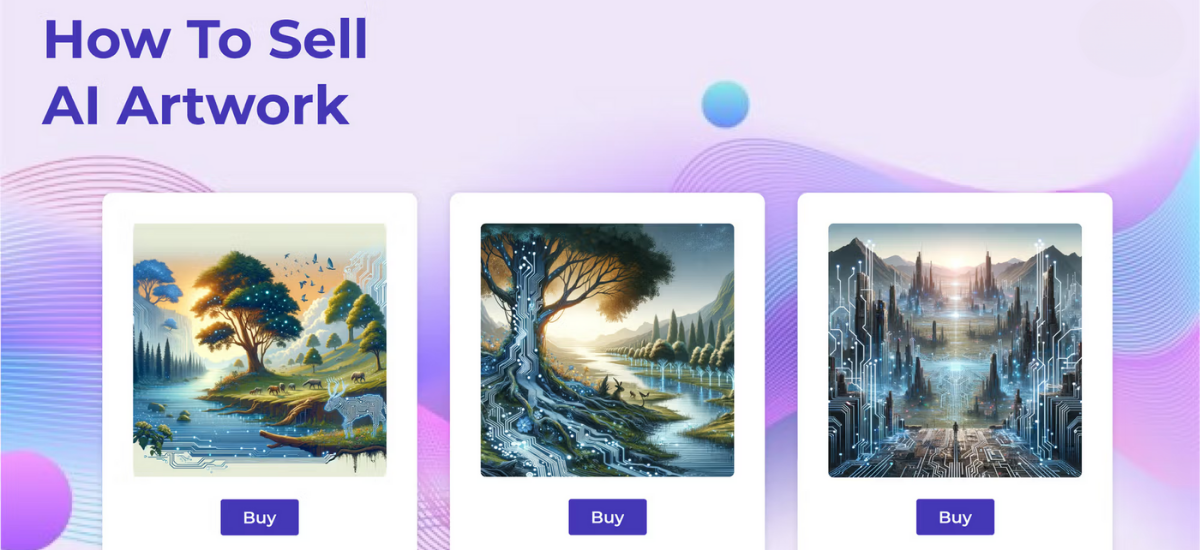
In the evolving landscape of creativity and technology, artificial intelligence (AI) has unlocked new opportunities for artists and entrepreneurs alike. One of the most exciting developments is the ability to generate stunning digital artwork using AI tools like MidJourney, DALL-E, and NightCafe. Even if you have no design background, you can now create, market, and sell AI-generated art as a profitable side hustle or full-time business. Here’s a comprehensive guide on how to monetize AI-generated art without being a designer yourself.
1. Understanding AI-Generated Art

AI-generated art refers to visual content created using machine learning algorithms that can interpret text prompts and generate images accordingly. These tools use massive datasets of images to learn styles, patterns, and visual structures. For example:
- MidJourney creates high-resolution images based on descriptive text prompts.
- DALL-E by OpenAI produces creative visuals from simple language instructions.
- NightCafe offers various artistic styles and customization options.
With the right tools and strategy, you can generate unique and appealing artwork in seconds. The key to making this work is understanding how to guide the AI effectively with your prompts and how to use those images in creative ways.
2. Choose the Right AI Tool

Start by picking an AI art generator that suits your goals. Here are some popular platforms:
- MidJourney (via Discord) for high-quality, stylized art.
- DALL-E 3 for concept art, product mockups, and imaginative scenes.
- NightCafe for print-ready formats and different artistic styles.
- Artbreeder for generative portraits and characters.
- Runway ML for AI-powered video and image creation.
Experiment with each to understand their strengths. Some platforms may require a subscription or credits for high-res downloads. Test different prompt styles and observe how they impact the generated images.
3. Create Niche-Specific Artwork
Finding a niche helps you stand out in a crowded market. Popular niches for AI art include:
- Fantasy and sci-fi scenes
- Abstract patterns
- Nature and landscape art
- Pop culture mashups
- Inspirational quotes with artistic backgrounds
- Minimalist designs for modern decor
- AI portraits and digital avatars
Research current trends on platforms like Etsy, Redbubble, or Pinterest. Tailor your AI prompts to meet the demands of your chosen niche. Keep a notebook or spreadsheet with your best-performing prompts and their results. This can help you maintain consistency and speed up your creative process.
4. Platforms to Sell AI Art

There are multiple ways to monetize your AI creations. Here are a few top platforms:
a. Etsy
List AI-generated prints as digital downloads. Buyers can print them at home or at local print shops. Ensure high-resolution files and attractive mockups. Offer bundles and seasonal collections to encourage multiple purchases.
b. Redbubble / TeePublic / Society6
Upload your designs on merchandise like t-shirts, mugs, phone cases, and posters. These platforms handle production, shipping, and customer service. Use high-quality mockups to attract buyers and add detailed descriptions.
c. Gumroad or Payhip
Create digital art bundles or exclusive collections for direct downloads. You can also offer usage licenses for commercial projects, especially if your work fits into branding or marketing purposes.
d. NFT Marketplaces
If you’re interested in blockchain, mint your AI art as NFTs on platforms like OpenSea or Rarible. Make sure your work is unique and has value to collectors. Provide background stories for your art to increase engagement.
e. Print-on-Demand Services
Services like Printful, Zazzle, and Printify allow you to create and sell physical products using your AI designs. From canvas prints to custom apparel, the possibilities are endless.
5. Legal Considerations

While AI art is accessible, copyright and ownership issues can arise:
- Read the terms of service of the AI tool you use. Some platforms limit commercial use.
- Avoid using copyrighted characters or logos in your prompts. Be original.
- Clearly state in your listings that the artwork is AI-generated. Transparency builds trust.
- Consider licensing your work for commercial use where applicable. You can create your own terms of use for buyers.
It’s also smart to watermark your preview images or use lower resolution previews to prevent unauthorized usage.
6. Marketing Your Art

Effective marketing will make the difference in your sales. Use these strategies:
a. Social Media
Share your art on Instagram, TikTok, Twitter, Facebook, and Pinterest. Use relevant hashtags and trending sounds. Create short videos showing the prompt-to-art process to engage viewers.
b. Email Marketing
Build a subscriber list and offer exclusive downloads or discounts to your audience. Use platforms like Mailchimp or ConvertKit to stay connected with fans.
c. SEO Optimization
Use keywords in your product titles, descriptions, and tags. For example, “AI-generated abstract wall art” or “digital fantasy printable.” Include alt text for images and optimize file names for search visibility.
d. Content Creation
Create behind-the-scenes content showing how you generate your art. This builds trust and engages potential customers. Write blog posts or film YouTube tutorials that explain your process.
7. Scaling Your Business

Once you find what works, scale your AI art business:
- Automate listing creation with tools like Canva and mockup generators.
- Hire a virtual assistant to help with customer service or uploading.
- Bundle artworks and offer seasonal collections.
- Offer commissioned pieces using AI customization based on client prompts.
- Partner with influencers or art communities to cross-promote your shop.
Reinvest a portion of your profits into advertising, new tools, or expanding into new platforms.
8. Real-World Success Stories
Many entrepreneurs have successfully launched digital art stores using AI. For instance:
- A creator on Etsy selling fantasy AI art made over $10,000 in six months by targeting roleplaying game enthusiasts.
- A TikTok user built a Redbubble shop featuring AI botanical prints that went viral, leading to passive sales daily.
- Designers using MidJourney to make mood boards and sell to interior decorators, creating a new source of passive income.
These stories prove that creativity combined with strategy can be very rewarding. AI gives everyone the chance to be part of the creative economy.
Final Thoughts
You no longer need to be a trained designer to make and sell stunning digital art. With AI tools at your fingertips, you can explore endless creative possibilities, tap into profitable niches, and build a scalable business from home. Whether you’re a student, a stay-at-home parent, or someone looking for a new income stream, AI-generated art provides an accessible entry into digital entrepreneurship.
Start with a clear vision, stay consistent, and don’t be afraid to experiment. AI art is not just a trend – it’s a gateway to creative entrepreneurship. The only limit is your imagination – and with AI, even that can be expanded.






